Those who think comics need to ditch the direct market right this minute had better not read the latest news about Barnes and Noble. The last big box chain had a dismal quarter, fired its CEO, and is looking to shore things up.
Concern about Barnes & Noble’s Nook business gave way to worries about its core retail operation when the country’s largest physical bookstore chain reported disappointing results for the first quarter of fiscal 2017, which ended July 30. Though Nook sales have been falling for a long time, and fell again in the most recent quarter, B&N did manage to cut the digital unit’s losses in the latest period. Sales at its retail stores, however, fell 6.1% compared to the same quarter last year, and the division had an operating loss of $7.4 million, compared to operating income of $20.5 million in the quarter ended Aug. 1, 2015. Comparable store sales dropped 6% and were down 5.2% excluding sales of Nook products.
A lack of big hits and the softening of the adult coloring book market were blamed for the decline in book sales, along with a challenging retail environment in general. If by “challenging” you mean terrible, as CEO Len Riggio put it:
“[T]he retail environment is not good at this moment, in fact it’s terrible,” CEO Leonard Riggio said on the company’s conference call. “It is one of the worst I have ever experienced in the 50 years I have been in this industry.”
Yuck.
In the meantime, if you have a hankering for banners that say “Hastings” or perhaps a 1.1 millions email mailing list, the auction for the remaining assets of the bankrupt chain Hastings ends this week. Details here.
I investigated the effects of the Hastings bankruptcy on the comics industry a bit at the Diamond Retailer Summit and Baltimore Comic Con. No one seemed to be stressing over it, although as one comics sales type told me, “Do the math,” meaning, no one likes to lose sales. My general impression was that no one was happy to lose a good sized account, but as far as Diamond was concerned, the handwriting had been on the wall for a while, and precautions were taken to make sure it wasn’t a huge blow. I’m also told that Diamond is reaching out to indie bookstores in markets that lost a Hastings to see if they want to try to pick up some of the customers.
But let’s try to look at the bright side. The direct sales market is very far from perfect, but far from crushing comics sales in their infancy, it’s actually a pretty strong base for publishers. The lack of returns (in general) allows for more stability and sales predictability, and while there is plenty of tinkering and adjusting going on, and we’re going to see some publishers go by the wayside or consolidate in the next couple of years, we also have a bunch of publishers who debuted in the last decade or so who are either expanding or still around including Aftershock, Double Take, Valiant, Joe Books, Black Mask, and Lion Forge. I don’t endorse the business models of all of these publishers, but this is the definition of a “growing industry” at the moment.
And while I doubt the “burn it down” faction will believe this, comics retailers as a group have improved quite a bit in the last decade or so, and the availability of strong products in book form and a widening of the kinds of material available have allowed retailers who look outside the big two to get more customers and sell more books. And of course, the return of female readers and kids means more customers to sell too.
https://twitter.com/lesdoggg/status/763274669071949825
Man if I had this briefcase….I dint know mane. Love these books! pic.twitter.com/ZPDFq0NFmt
— Leslie Jones 🦋 (@Lesdoggg) September 4, 2016
Also, comics and graphic novels have a huge acceptance in all four quadrants now. How many times over the years have I sat in a meeting where someone pined for a “milk board” for comics, meaning a comics version of those old ads where celebrities were shown drinking milk, implying that it was a healthful beverage and not a cup of poisoned cholesterol. Now every celebrity has a role in a comic book movie, and social media images of actors reading comics (such as those accompanying this piece) are hip and cool. Just like comics!
That’s all painting with a broad brush, of course, and there are many flaws in the system, including the call for “preordering.” But some of these problems are at least being identified. Another impression I got from talking to retailers and publishers at the Diamond summit is that the annual ComicsPRO meeting has really become a valuable workshop, where the industry gets together and tries to address issues. It’s still a closed system, but it’s better than nothing.
(Aside: at the Diamond event last year, there was, I think, an attempt to replicate the ComicsPRO experience a little by having publishers set up and make presentations to groups of retailers who cycled through each booth. This year, it was a very different set up, with an exhibit hall that was open for an afternoon, with creators signing. I polled retailers on which they preferred and it was pretty much evenly split! The 2016 exhibit hall — with long lines for the likes of Kevin Eastman, Jim Lee, and Scott Snyder and Jeff Lemire — was much livelier and exciting, no doubt. And people could do it at their own pace. The more intimate setting of the presentations also had fans, though, as did the ability to ask questions in a smaller setting.)
I’m not one of the people who believes that the greatest evil in the comics industry is Diamond, either. Would we be better off with more than one distributor? Absolutely. Luckily there are distributors besides Diamond, and many shops use them for books: Ingram, which carries a huge array of titles, for instance, or even individual book distros like Random House or Consortium. Or the indie guy Tony Shenton, who is pound for pound the most irreplaceable man in comics. As yesterday’s IDW to Penguin Random House news showed, this is a constantly shifting landscape.
Of course, getting material in a timely and safe fashion from Diamond can be a problem. At this years summit, as at every other one I’ve attended, the retailer Q&A session was all about damages. In the past this session was mostly about boxes that were damaged in transit, but this time it seems that comics are getting damaged while packed. Ironically, before this bitch session, a Diamond rep had given a lengthy, technical presentation about how they are expanding their Olive Branch distribution center with a new picking station and more sort bins, things which I gather, represent an investment in shipping books more safely.
That didn’t stop the complaints from retailers, though, including a dramatic Maury Povich style presentation of a damaged box from one retailer. Finally a different Diamond rep (I think it was John Wurzer, but my notes don’t say — apologies) said that they had looked to other industries to find a model so they could copy their best practices, but they couldn’t find another company that does what they do.
This is something people forget, I think. Even if Marvel and DC didn’t have exclusives with Diamond, it’s extremely unlikely anyone would be crazy enough to get into the periodical distribution business. Given the vast number of SKUs and vendors, the weekly lay down, and the very, very vocal customer base, the investment just to get things sorta right would be huge and the profit margin relatively slim.
Once again, I’m not saying that a still thriving Capital Distribution and even Heroes World operating today wouldn’t mean certain things were better. But it’s complicated. I heard that several histories of the direct market are being written, and those should be interesting and required reading.
The other great outcry we’ve been hearing is “We need more comics for kids!” which is certainly true, but just about every publisher’s presentation at the summit included all ages comics, so there are comics for kids available. I must confess in looking at Marvel’s huge push for The Champions, a team comprised of its most teen-friendly characters, I wondered if this was another book aimed at the Scholastic book fair market, and according to Rich, my guess was right. Go me! Although, admittedly, that wasn’t much of a leap.
The monthly sales charts that David Carter and Xavier Lancel produce here do show “standard attrition” and a steady drip drip for sales resembling a clogged tub draining, and do give the impression that it’s all winding down. But a look at John Jackson Miller’s charts and graphs at Comichron gives a more optimistic view of a general trend upwards. Since cover prices have increased, let’s only look at units. I’m sure he won’t mind my stealing a couple of charts.
UPDATE: Incredibly; Miller just today updated these charts! PLus I incorrectly posted the dollars chart by mistake (ahem, bad eyesight>BIG TITLES). So here are the current charts!
Here’s comics ORDERED through Diamond from 1996 to September 2014 1Q 2016.
And combined comics and graphic novels through 2Q 2016.
And for reference, here’s the DOLLARS chart.
Doomsayers will say that the big drop took place in 2015-16, and I would like to see updated charts, Hey we do have updated charts, but the general trend for 18 years was upwards, and we have a bigger industry – when graphic novels are factored in – now than we did in 1996, which was a pretty good year before the big bust. Doomsayers will also point out that this is SELL IN not SELL THROUGH and that is true, but as the whole preordering megillah shows, comics retailers order to sell out, so while over ordering takes place constantly, this is still a reasonable snapshot of sales for publishers.
UPDATE: Could it possibly be that it is the pamphlet format itself that is problematic and not the delivery method? And don’t say they should be cheaper. According to the Satisfying Chunk theorem, maybe people just get more satisfaction out of spending $14 for a complete story than spending $4-5 for an episode. People stream stuff by the show not by the episode.
Once again things aren’t perfect, there are chokepoints, Diamond’s infrastructure needs updates, retailers need more capital and publishers need to take more chances. But there is a promising baby here, and getting rid of some greyish bathwater shouldn’t necessitate leaving the kid on a mountaintop.
Graphic Policy’s Brett Schenker shares my views of the industry, and has been crunching numbers and making charts in his own series of articles. His titles may be too vague and elliptical for some THE COMICS ARE ALL RIGHT: THE TRUTH IS IN THE NUMBERS and just yesterday THE COMICS ARE ALL RIGHT: THE COMIC MARKET IS MORE THAN DIAMOND, MARVEL AND DC
Shown in my first article, “The Truth is In the Numbers,” we see that the number of comics outside of the top 300 comic unit sales estimated by ComiChron has grown 150.85% since 2009 compared to the top 300’s 19.08%. If the cards were stacked against small print comics that number would most likely be flat, decreasing, and at best within the margin of growth of the top 300 comics. That’s not the case at all and either more series are being sold and/or more comics of those series are being sold. Either way, this dispels a lot of rumors.
If you’ve come this far with me, I suggest just going over there and reading Schenker’s entire analysis as he lists a ton of alternative places to buy comics from Kickstarter to Tapastic and our views are quite similar.
In 2015 DC’s shocking decline after DC You, and Marvel’s continued reliance on soft reboots with similar names definitely alarmed many people, and with good reason. Sales dropped for the first time in a while, and drastic measures involving the minutiae of continuity had to be taken. This recent uneasiness has led to the current spate of think pieces on the state of the market, most recently touched off by the cancellation of Nighthawk. I’m not going to analyze these all, but for your reading pleasure here’s a partial list.
There’s a lot more out there, and this kind of period of reflection and analysis is a great thing to see what needs fixing and where the trouble spots lie.
But I just don’t believe the evidence suggests that we’ve developed a horrific system that is choking the life out of comics.
§ Joe Illidge was actually first out of the gate with Nighthawk’s Fatal Battle Against A Civil War And A Rebirth, which elicited fairly little comment given that it looked at the issue in terms of race, which is what the whole book was about to begin with.
§ You’ve probably already read Jude Terror’s Die industry Die! and my rebuttal.
§ Terror was back with Doubling Down: Comics Is Burning, and I’m Playing the Fiddle where he refutes everything I just wrote:
Comics industry apologies would have you believe that recent, minor spikes in growth of comics sales mean everything is just fine, that DC’s Rebirth titles (which are returnable, by the way, like the news stand comics of old) are selling 200,000 copies (to retailers, not readers), and that direct market comic sales are up from where they were at six years ago. They’ll argue that movies and TV shows based on comics serve as the new entry point for readers. But these things represent a minor improvement on an entirely broken system, not a great hope for the future of the industry, and any real growth in the readership is coming from creator-owned comics that explore new genres and concepts instead of retreading the same storylines from decades past over and over.
They’ll point to comics outside the Diamond ecosystem, like “Smile” by Raina Telgemeier, which are far more successful than anything Marvel or DC put out, as examples of the industry thriving, ignoring the fact that Smile and similar comics, just like creator owned comics, are not a part of the superhero industrial complex I’m railing against.
I know I said I wouldn’t get into it, but I just can’t stand this “reasoning.” The death of the industry is posited; a countering situation is pointed out; that countering situation is dismissed because “it doesn’t count.” If you go to McDonald’s and complain about the greasy burgers when there is a nice salad bar next door, you are the one who is choosing an unhealthy diet, not the food industry. DC and Marvel are weird, no question, but they are far from the only comics out there, and far from the only “successful” comics. Why shouldn’t this count as progress?
§ WHEW! Anyway, Abhay Khosla, OF ALL PEOPLE, also chimed in here and here.
§ Christian Hoffer had a measured take for ComicBook.Com: Who’s To Blame When a Good Comic Gets Cancelled?, suggesting returnability was a valuable tool to get more sampling.
§ There were at least two other pieces that were thoughtful and I thought I bookmarked them but…I guess I didn’t and my feed streamed on. If you have a hot take, list it in the comments.
§ Here’s at least one, by Emma Houxbois, who cleverly used Batman #44 as a lens for her take:
Terror in particular was more or less accused of peddling that kind of romantic narrative in his screed against the direct market and criticized for not delving into the long and winding path that has lead the industry to its current position. The difference of course is that Terror, nor Dillinger are Bruce Waynes possessed of the means and influence to take the wheel and steer us into the promised land. They’re vigilantes in the truest sense, blunt and vocal members of the comic press’ fifth estate. The spleen of the comics Internet. To focus on the flaws, whatever they may be, in their arguments rather than chase the threads they unravel is a symptom of the deep myopia that really killed Nighthawk.
§ Finally, while I was writing this I found two links that may be of interest. Here’s Gina Gagliano at First Second talking about book distribution and a Storify compiled by A. David Lewis from nearly two years ago with complaints about Diamond. You see, this current crisis is just another reboot after all.


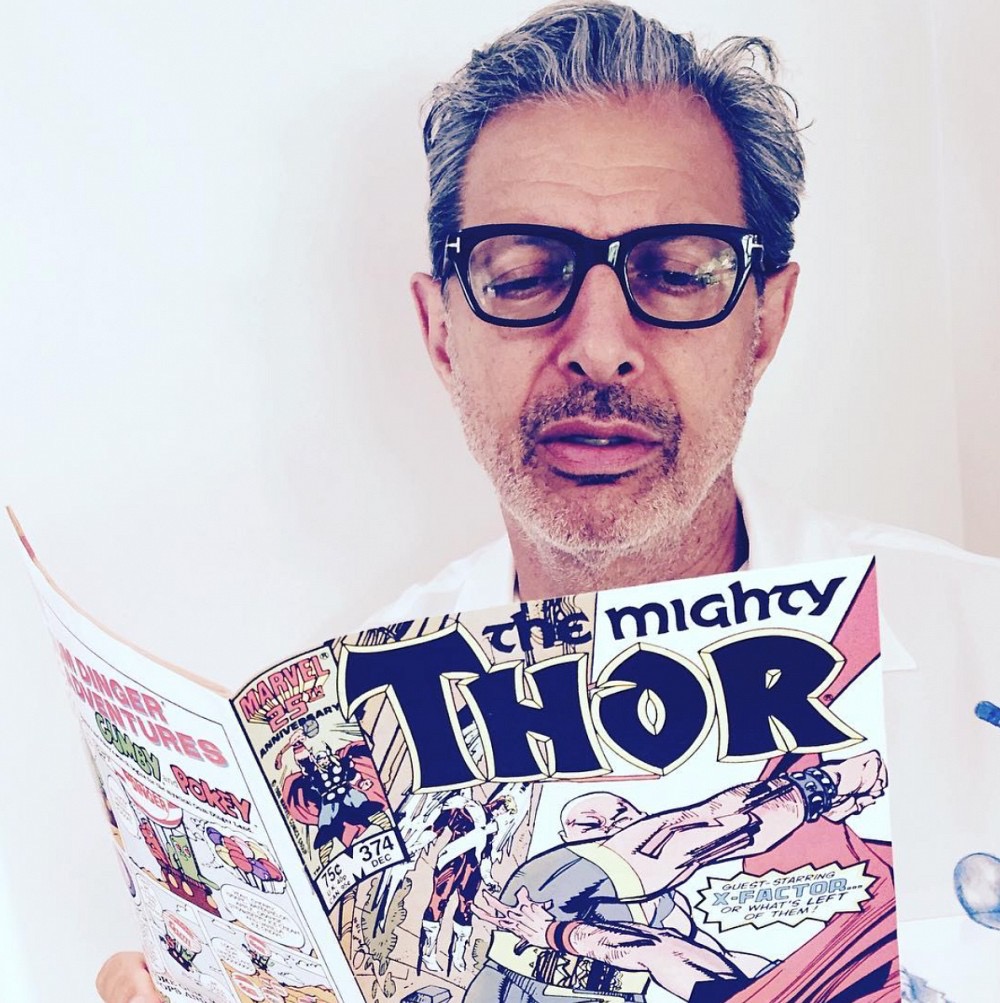
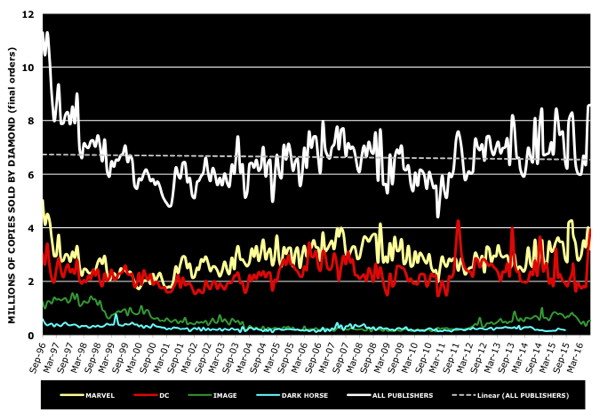
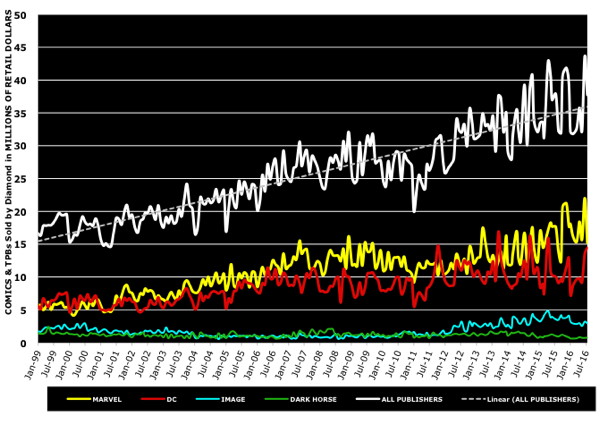
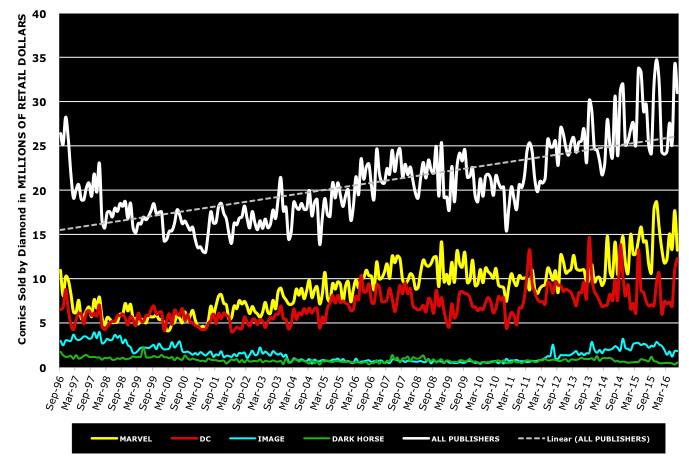
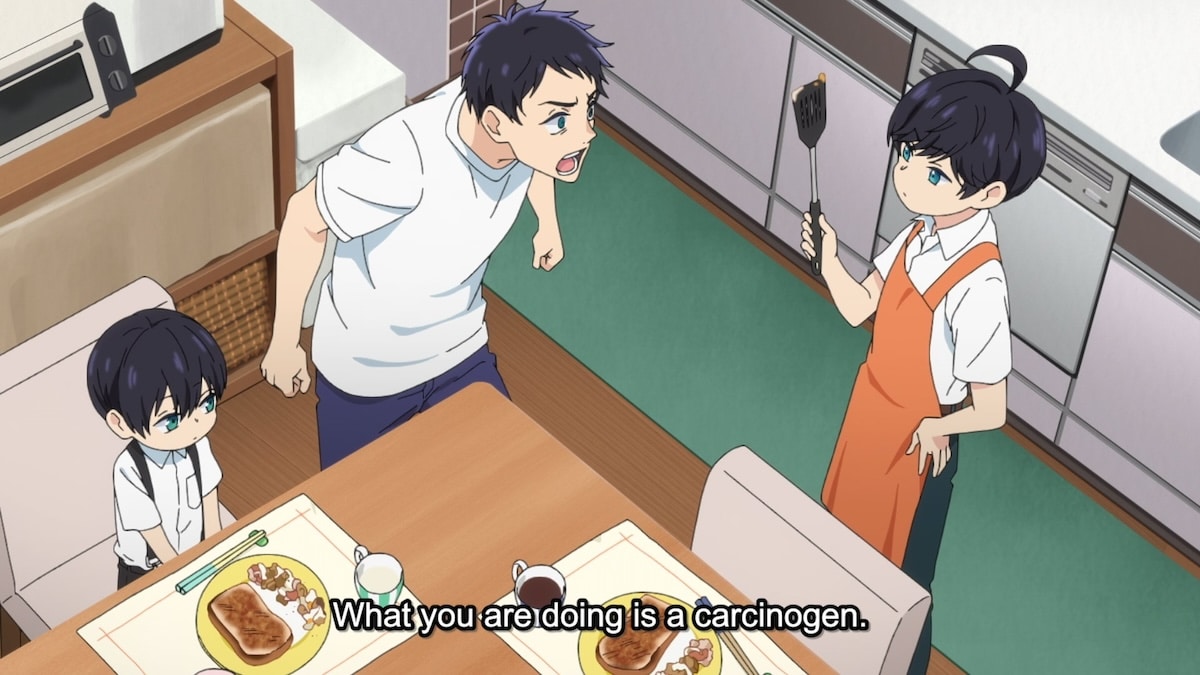
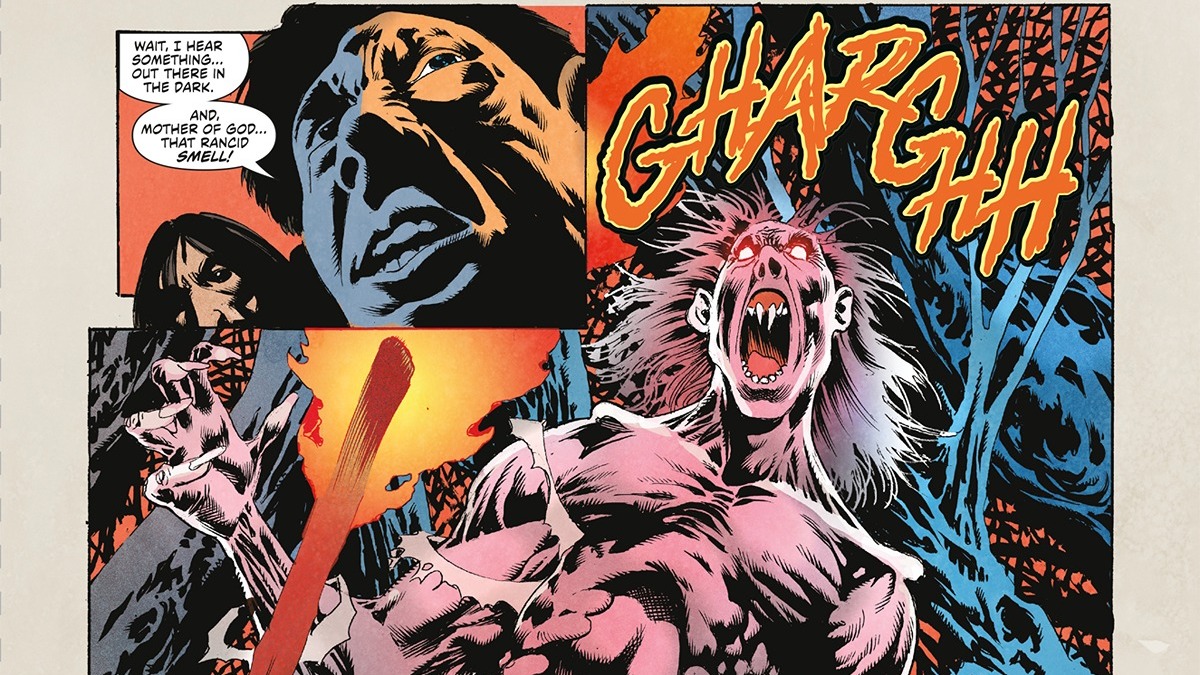
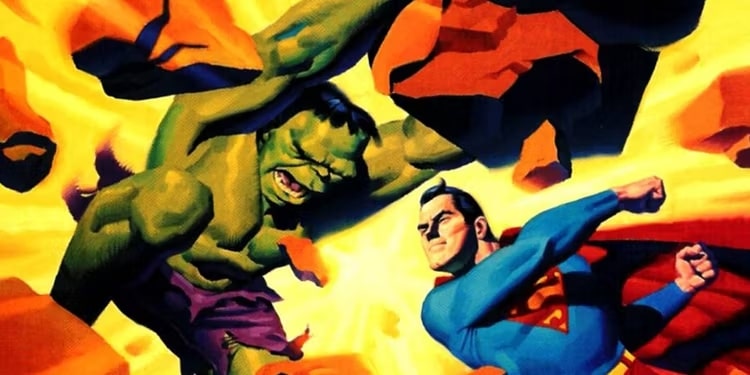


I’m not a comics doom-and-gloomer, and overall I think this is a good post!
However, before you show the charts, you say, “since cover prices have increased, let’s only look at units.”
But the Y-axis for those charts is in “comics [& TPBs] in millions of retail dollars.”
It looks to me like those charts show prices instead of units, is that incorrect?
i’m very torn on the issue. I like physical retail and comic shops, but as i get older, find them more difficult to get to. I live in the suburbs of a major city and the closest comic shop to wear i live is 20 miles away. There’s actually one a few miles from where i work, but they have hours that aren’t aligned for people who work at a salaried job with responsibilities. (10-5)
I could make special trips but its not really realistic. So amazon, digital comics etc…that’s why i do. I dunno, i think comic shops are a destination to pick pre-ordered things up at full retail price and that’s about it. I”ve shopped at a few dozen over the years and never really felt that strong sense of community or customer service that so many talk about. I can get recommendations online and find better prices too. My town is full of kids and families, and our local bookstore and library have robust comic sections, but i worry that as kids grow up in an on demand world, telling them they need to order something out of a catalog 3 months in advance will be like expecting them to use a rotary phone in the kitchen in lieu of their iphones. So i just don’t know. I think that they direct market needs to adapt for the next generation somehow.
Given the state of periodical distribution (Ingram seems to be the last man standing…), I don’t think there would be more than one comics distributor in the current market.
Another Zeitgeist is this: superhero comics are no longer the dominant genre of comics. Some people don’t want to consider this possibility, but it’s there. Diversity is changing the market, While I don’t see superheroes going the way of the pulp heroes (an aging fandom with little fresh blood), at best, superheroes will be like romance paperbacks. (They already are… Harlequin prints most series 4-8 times a month, aimed at specific demographics like NASCAR fans, paranormal, spicy, ranchers, single mothers… 19 currently. http://www.harlequin.com/store.html?cid=233 )
Starting these charts from 96 and 99 is highly misleading- those are both post-crash years. And even so you have what, a 35% drop in overall unit sales in the past 10 years? A marginal uptick in dollars even with a near doubling in cover prices? And how many Indy creators are supporting themselves doing comics, never mind making good livings? For that matter how many people on marginal titles for major pub’s are making decent salaries? How many retailers are eating stacks of these rebooted books? How many stores do we have today compared to 10 years ago? 5 years ago?
There’s no way this is a healthy business. Ask creators. Ask retailers. If we lose Barnes and Noble, I don’t know what’s going to happen.
Correction 35% unit in 20 years
I don’t know Jude Terror personally, but that guy seems insufferable. Like the cynical, self-righteous hipster who proclaims everything to be ‘trash’.
Words could’t keep the Titanic afloat, but they sure could cheat some schmucks of their lifeboat!
> this is the definition of a “growing industry”
Aftershock is named, but considering their practice of baiting books at $10 and stealthily shipping them at $18 to pre-order suckers, aided and abetted by Diamond — doesn’t this seem a growth in the cancerous sense? (Not that they should be singled out, as many have been happy to cheat, including D&Q, Fanta, SelfMadeHero, Dover, etc.)
Isn’t it more interesting to look at revealed preferences rather than expressed preferences, or to pay attention to what The Man behind the curtain is doing rather than what he’s saying? Such as publishers moving out of Diamond, or milking the DM like they expect it to collapse anyway and have decided to carve a cow they won’t milk for much longer.
Honeyed words can always be found to excuse toxic practices, but milked and bilked customers are always right to defect to Amazon and libraries, Comixology and torrents. (Not unlike how denied voters defect to Trump and other populists.)
> the softening of the adult coloring book market were blamed for the decline in book sales
Now that was priceless.
Barnes & Noble has been in trouble for a very long time. They were horribly mismanaged and the Nook did tons of damage. Just because you noticed that now doesn’t mean the direct market isn’t awful.
The biggest problem with the direct market is it places all the risk on retailers to guess how many books they need to order with no error for margin. The companies with the coffers big enough to absorb the risk are shifting all of it to the little guys.
There are good direct marker stores, sure, but good and bad, they’re all under the same terrible structure. It should never be their fault a book doesn’t last because they didn’t order enough.
It’s a bad system.
Heidi – this was a richly informed article that offered a lot to think about. Thank you. I’d like to add a note about “pamphlets” or “floppies.”
I have recently been reading “Invincible” from the beginning, in the Ultimate Editions that are available at my local library. I’d never read the series before, and I have enjoyed it a lot. It’s a little odd to note this, but I did miss the “wait-time” between monthly issues. For example, as I eagerly now await the outcome of “Jupiter’s Legacy” by MIllar and Quitely, I sometimes reread the previous issues and savor them in anticipation of the next, hopefully-coming-soon chapter. With “Invincible” Ultimate Editions, I read ten or more issues in a sitting and move on, never rereading them… or almost never. And not just because I have to get the books back to the library!
There’s a kind of reader investment in monthly (or, at any rate, periodical) installments. I imagine this kind of bond between the reader and the creators works best when the creative team is consistent, as with “Invincible” or “Savage Dragon.” It is also related to high-interest projects that readers simply must have – the ones they can’t wait upon even if they buy the “floppies” now and the collected book later. That’s no doubt what is happening with me and Alan Moore’s “Providence.”
Back to the question of money… I have an idea that would make for a good investigation. How much did “Battling Boy” make? It came out as a complete (ish) book, right? What if that book were divided up into four or five installments and sold as floppies, and then collected? Would it have made even more money? What if Scholastic divided up Raina Telgemeier’s “Ghosts” into four “pamphlets” and sold it before issuing the book?
What hath Jude Terror wrought, that any of us should be mindful of him?
” comics and graphic novels have a huge acceptance in all four quadrants now. How many times over the years have I sat in a meeting where someone pined for a “milk board” for comics, meaning a comics version of those old ads where celebrities were shown drinking milk, implying that it was a healthful beverage and not a cup of poisoned cholesterol. Now every celebrity has a role in a comic book movie, and social media images of actors reading comics (such as those accompanying this piece) are hip and cool. Just like comics!”
That’s called being trendy, Heidi. IP that comes from comics make a lot of money for Hollywood. Celebrities who want to keep on living the Good Life are wise to make a post on social media showing their comic book street creds in the hope of being considered for roles in future comic book films, television shows, video game voicing. This has nothing to do with whether they read comics, or respect them and everything to do with survival.
There’s still a lot of work to be done to make comics as ubiquitous as they were in the 1960, 1970s, or 1980s. Right now, the consensus is that less units are being sold than in the 1960, 1970s, or 1980s which makes comics by definition of not a “growing industry”.
Just because there are no major publishers filing for bankruptcy, does it mean that comics are performing significantly better. Comics are a product that, face the challenges of distribution and marketing. The shuttering of a major bookstore chain should be of a concern since many GNs cannot be found at the local Target and advertising is non-existent.
@Steve Replogle:
FWIW, in my experience the best ROI in “wait-time” is to read one chapter per day, whether it’s from a collection or a stack of unread issues.
I get the best of both worlds, as I can more easily keep track of story details while still experiencing a daily cliffhanger. (Cliffhangers and such, at least to me, have rapidly diminishing returns with wait-time, so one month brings little more than one day and isn’t worth the loss or blur of story details.) As with studying and other problem-solving, the key thing seems to have one night of sleep over what you’ve read.
And of course, it’s easy to read this way from several trades at the same time. (So for every day of one week I could get to read, say, one chapter from a sci-fi trade, one from a crime trade, etc.) Well, works for me!
I absolutely agree with Heidi’s comment about the pamphlet/floppy form and the “satisfying chunk.” I was a Wednesday Warrior for from middle school through college (c. 1992–2002) and then spent about a decade away from comics. Now I’m back in, but I’m 100% graphic novels and trade paperbacks, no floppies now. And I can’t imagine going back to the trickle of story that monthly floppies provide.
Mostly I read back catalog material that’s complete (read all of Preacher over about four months this spring; reading Sandman now) at a much faster pace than it was originally published. And the few current monthly series where I’m up to date (relative to the trades) such as Saga, Sex Criminals, and Paper Girls actually frustrate me that I don’t have something complete.
I’m about to the point where I don’t even consider a five- or six-issue trade a “satisfying chunk” if it’s part of a larger ongoing story. The most recent trades of all three current series I just mentioned underwhelmed me wrt the amount of content/story: “Really? That’s it?”
Terrific article, and one that offers some interesting links. Many thanks. I’m not sure why there are images of 100 BULLETS plugged into the middle of the thing but, hey, fun comic, great artwork, I’m good with it.
While it’s never good news to see another comic book outlet go away, B&N has been struggling for quite a while. The one in my town closed over two years ago. When I visited the closest one to my house a month ago — it’s 120 miles away — they told me they were reducing book and periodical stock to offer some additional space for more toys, mugs, and other such nonsense. Higher profit margins, I suppose.
Less reason for me to visit. Without a LCS anywhere near to me, I’ll continue buying online.
Comments are closed.